Today, curatorship is a concept that appears not only in the art world but in many areas of our lives. Curated menus, playlists, fashion collections… all are arrangements shaped by aesthetic choices and designed to tell a “story.” Yet the origin and meaning of this word go much deeper.
Origin: “Curare” – To Take Care
The word “curator” comes from the Latin curare, meaning “to take care.” In Ancient Rome, curatores were public officials responsible for the functioning of urban systems such as aqueducts, buildings, and even sewers. They were the people who “took care” of the physical order of society. By the Middle Ages, this meaning had shifted; the curatus had transformed into a figure responsible for the spiritual well-being of people — a “caretaker” concerned not with buildings but with souls.
Centuries later, the concept was reborn in the art world: this time as the guardian of artworks, objects, and ideas.
Curators of Meaning
By the 20th and then the 21st century, curators had become not only the “keepers” of art but also the “creators of meaning.” When you enter an exhibition, you are actually stepping into a story. The curator builds that story by bringing together artworks from different periods, disciplines, or aesthetic approaches. Wall texts, catalogues, spatial design… all unite around a central idea. Thus, even works that seem distant from each other can form a whole — to evoke new feelings or new thoughts in the viewer.
These stories change over time. In the early 20th century, curators brought together artists like Picasso and Matisse, who challenged linear perspective. In the 1950s and 60s, narratives revolved around abstract expressionism, the Cold War, minimalism, or civil rights.
But not every story was the right one; sometimes, curatorial mistakes went down in history — as in the Royal Ontario Museum’s 1989 Into The Heart of Africa exhibition. The show was later criticized for reinforcing racial biases and became a case study for “how not to curate.” Yet the same museum later created exhibitions such as Of Africa and Here We Are Here: Black Canadian Contemporary Art, turning its earlier mistake into a new awareness — redefining the power of representation.
The Contemporary Transformation of Curatorship
So why has the concept of curatorship expanded today to menus, playlists, and even the fashion world? Because “curation” now represents an aesthetic choice, a point of view. A restaurant menu, a fashion collection, or a playlist tells its own story. Yet perhaps we have overused this word — because true curatorship is not merely about choosing, but about transforming meaning. Curators are the people who change the way we look at history, complicate old ideas, and show how art reflects — and challenges — the world.
Art Carried Into the Future
Today, curators are among the most important advocates of equal representation in art. From Black artists to Indigenous artists, from individuals belonging to marginalized communities to many others, they ensure that everyone finds an equal place in art history. They help us understand why artists create and allow us to see artworks within their contexts. They bring new ideas into culture and allow us to see art in ways we never have before.
We can think of curators as cultural caretakers who carry us into the future — bringing art with them, carefully, patiently, constructing stories.
Source: Lise Hosein, “Art 101: What Does a Curator Actually Do?”, CBC Arts



